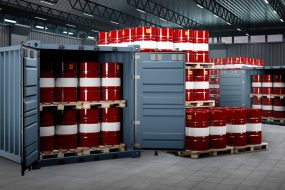How oil and gas companies can leverage warehousing opportunities to cut down on lead time and optimize their supply chains
With the massive scope and scale of oil and gas operations, and the thousands of assets involved in extracting hydrocarbons, warehousing is a critical part of the value chain. It is also complex and can make or break drilling operations for oil and gas companies.
“The main challenge for oil and gas companies is lead time,” says Georges Yacoub, global operations manager at Aramex. “Lead time is the most important factor in supply chains. Certain items need to make it to the right place, at the right time, or rigs cannot operate, and oil producers can lose huge amounts of money.”
Lead time is impacted by a host of factors in the warehousing space, including stock accuracy and integrity. If items are not available in the warehouse, operators have to order more from their suppliers, adding both time and costs to their project.
Similarly, if the warehouse is not operating at all hours, backlogs can grow and operators won’t be able to place orders whenever necessary. Yacoub says that after changing from normal shifts to operating 24/7, backlogs balanced out as work could be spread out across the day and the week.
Stock doesn’t only need to be available at the right time, but also in the right place—the layout and setup of the warehouse is deeply important. “It means making sure that stock is in the right location, so fast moving items can be easily accessed quickly, and so that employees don’t have to travel long distances to get to them,” Yacoub says.
This leads back to setting proper processes and protocols in the warehouse, and a strategic logistics partner can provide the resources to set up and maintain those processes with aim of reducing lead time, decreasing waste, and optimizing workflows.
Moreover, the warehouse itself has to be in the right place—while on the surface level a warehouse is one link in the supply chain, it actually has deep strategic value. Regulations differ country by country, and setting up a strategic hub can ease typical transportation and logistics issues. “Warehouses should be strategic points that can reduce lead time and consolidate inventory,” Yacoub says.


There are also innovative solutions to warehousing problems, like digital platforms that improve transparency and efficiency. When asked about digital solutions in warehousing, Yacoub noted that by creating a shared platform between the warehouse team and the team in the office, they could quickly share vital information to increase efficiency.
“When dispatching a shipment, the office team sends a request through the platform to the warehouse team to gather the orders and prepare them to be moved,” he says. “The warehouse team instantly has the information necessary to collect and prepare the materials.”
Using these digital platforms, oil and gas companies are also able to connect to the warehouse team to get transparency on their shipments, allowing them to monitor stock and inventory, which improves stock accuracy and inventory integrity. Efficient warehousing requires a strategic plan, a deep understanding of its role in the overall supply chain, and the mind-set that it presents opportunities to speed up and optimize operations, rather than becoming a stopping point for inventory, or simply a place to store items until they are needed.




